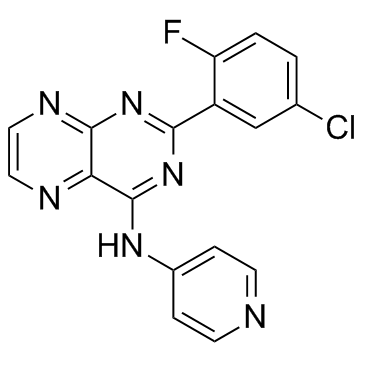627536-09-8
| Name | 2-(5-chloro-2-fluorophenyl)-N-pyridin-4-ylpteridin-4-amine |
|---|---|
| Synonyms |
ALK5 Inhibitor V
2-(5-chloro-2-fluorophenyl)-N-(pyridin-4-yl)pteridin-4-amine 2-(5-Chloro-2-fluorophenyl)-N-(4-pyridinyl)-4-pteridinamine SD-208 4-Pteridinamine, 2-(5-chloro-2-fluorophenyl)-N-4-pyridinyl- SD208 |
| Description | SD-208 is a selective TGF-βRI (ALK5) inhibitor with IC50 of 48 nM, and > 100-fold selectivity over TGF-βRII. |
|---|---|
| Related Catalog | |
| Target |
IC50: 48 nM (TGF-βRI) |
| In Vitro | SD-208 inhibits the cell growth and constitutive and TGF-beta-evoked migration and invasion, and enhances immunogenicity in murine SMA-560 and human LN-308 glioma cells[1]. SD-208 blocks TGF-beta-induced phosphorylation of the receptor-associated Smads, Smad2 and Smad3, and stimulates epithelial-to-mesenchymal transdifferentiation, migration, and invasiveness into Matrigel in vitro[2]. SD-208 also abolishes the promoting effect of TGF-β on neointimal smooth muscle-like cell (SMLC) proliferation and migration in vitro[3]. |
| In Vivo | SD-208 (1 mg/mL, p.o.) significantly prolongs the median survival of SMA-560 glioma-bearing mice[1]. In syngeneic 129S1 mice, SD-208 (60 mg/kg/d, p.o.) inhibits primary R3T tumor growth, and reduces the number and the size of lung metastases[2]. In the murine aortic allograft model, SD-208 effectively reduces the formation of intimal hyperplasia of transplant arteriosclerosis (TA)[3]. |
| Kinase Assay | Various kinase activities are assayed by measuring the incorporation of radiolabeled ATP into a peptide or protein substrate. The reactions are performed in 96-well plates and included the relevant kinase, substrate, ATP, and appropriate cofactors. The reactions are incubated and then stopped by the addition of phosphoric acid. Substrate is captured onto a phosphocellulose filter, which is washed free of unreacted ATP. The counts incorporated are determined by counting on a microplate scintillation counter. The ability of SD-208 to inhibit the respective kinase is determined by comparing counts incorporated in the presence of compound with those incorporated in the absence of compound. |
| Cell Assay | Glioma cells are cultured in the absence or presence of SD-208 (1 μM) for 48 hours. The cells are pulsed for the last 24 hours with [methyl-3H]thymidine (0.5 μCi) and harvested, and incorporated radioactivity is determined in a liquid scintillation counter. |
| Animal Admin | VM/Dk mice are purchased from the TSE Resource Center. Mice of 6 to 12 weeks of age are used for the survival experiments. Groups of eight mice are anesthesized before all intracranial procedures and placed in a stereotaxic fixation device. A burr hole is drilled in the skull 2 mm lateral to the bregma. The needle of a Hamilton syringe is introduced to a depth of 3 mm. SMA-560 cells [5×103cells] resuspended in a volume of 2 μL of PBS are injected into the right striatum. Three days later, the mice are allowed to drink SD-208 at 1 mg/mL in deionized water. The mice are observed daily and, in the survival experiments, sacrificed on development of neurologic symptoms. |
| References |
| Density | 1.5±0.1 g/cm3 |
|---|---|
| Boiling Point | 460.4±45.0 °C at 760 mmHg |
| Molecular Formula | C17H10ClFN6 |
| Molecular Weight | 352.753 |
| Flash Point | 232.2±28.7 °C |
| Exact Mass | 352.063965 |
| PSA | 76.48000 |
| LogP | 2.69 |
| Appearance | off-white to tan |
| Vapour Pressure | 0.0±1.1 mmHg at 25°C |
| Index of Refraction | 1.717 |
| Storage condition | 2-8°C |
| Water Solubility | DMSO: >5mg/mL |
| Symbol |

GHS07 |
|---|---|
| Signal Word | Warning |
| Hazard Statements | H302 |
| Personal Protective Equipment | dust mask type N95 (US);Eyeshields;Gloves |
| Hazard Codes | Xn |
| Risk Phrases | 22 |
| RIDADR | NONH for all modes of transport |
